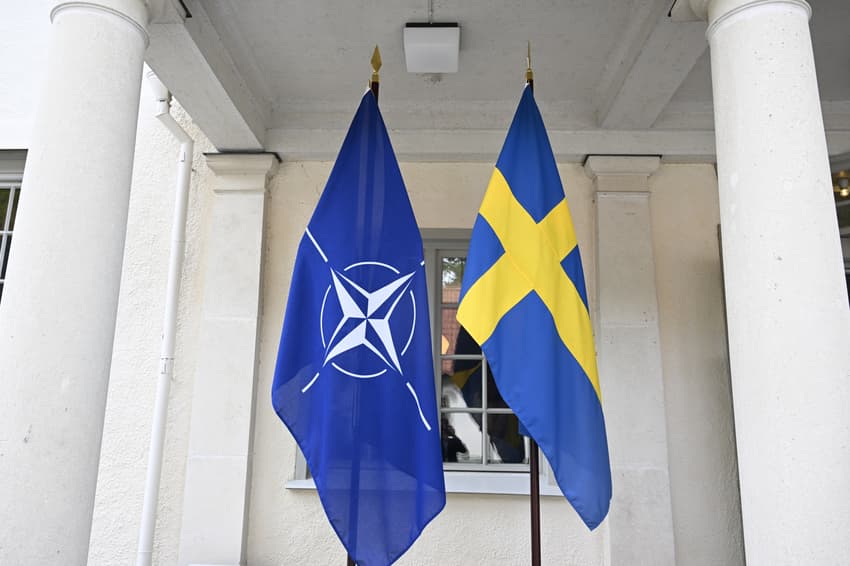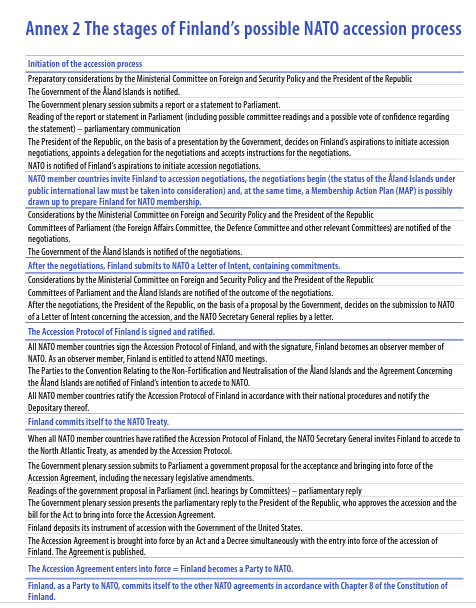TIMETABLE: Here's how long it could take for Sweden to join Nato

Sweden, along with Finland, were formally invited to join the Nato alliance on June 29th. Here's a timeline showing the path from application to official membership.
June 28th-30th: Nato summit held in Madrid.
June 29th:
- After weeks of negotiations, Turkey agreed to drop their veto of Sweden and Finland joining the alliance at the Nato summit in Madrid.
- Sweden and Finland were officially invited to join the Nato alliance, meaning the formal accession process can begin.
Magdalena Andersson called it a "historic day for the Swedish people", stating however that it could take up to a year before Sweden become members of the alliance.
July: As per Nato's procedure for accepting new members, Nato experts will hold in-depth discussions with Sweden (and Finland) over how the country's defence forces can contribute to Nato, any special requests from Sweden (such as a ban on nuclear weapons on Swedish soil), and how much Sweden will contribute to Nato's common budget.
On June 28th, Ann Linde said that this stage of talks would begin in Brussels "next week".
July: Sweden submit letter of intent to Nato, along with timetables for completion of reforms. The letter will be signed by Swedens' foreign minister Ann Linde, and addressed to Nato's Secretary-General.
July: Nato prepare an Accession Protocol to the Washington Treaty for Sweden. The protocol amends the Washington Treaty, and once signed and ratified by the Allies, it become an integral part of the Treaty itself and permits the invited countries to become parties to the Treaty.
July 2022-July 2023: Nato members ratify the Accession Protocols. The length of this stage is the most unpredictable, with different countries having different processes. According to TT newswire, this stage could take anywhere from a few months up to a year.
The US requires a two-thirds majority of the Senate to ratify a new member, while the UK requires no parliamentary vote at all. All 30 Nato members need to ratify Sweden's Accession Protocols.
Sweden and Finland are, however, both uncontroversial applicants (unlike say, Ukraine or Georgia), so member states' parliaments are likely to ultimately vote to let them join.
But it one or more of Nato's member states throws up objections, as Turkey did previously (perhaps seeking concessions on other issues), the process could get bogged down again.
Some point between end of 2022 and mid-2023: The governments of Sweden and Finland submit proposals to their respective parliaments to accept the accession agreement. Sweden and Finland become Nato members.

Here's the list of stages needed for a Nato application, taken from the Finnish government's new security analysis. Photo: Finnish Foreign Ministry
Below you can see what has already happened since Sweden and Finland began their processes in April.
April 13th: Finland publishes Government report on changes to the security climate.
April 18th: Finland's parliament begins a plenary session to discuss the implications of the new security analysis.
April 22nd: Social Democrats' parliamentary group and main committee hold "marathon meeting" on Nato.
April: Finland's PM Sanna Marin said on April 13th that her country's decision would take only "weeks". The next stage for Finland will be a second government report, which takes into account the issues raised in the parliamentary debate. A special parliamentary monitoring group, which includes party leaders and chairs of the key committees will play a big role in communicating to government what the political consensus is.
May 9, 10, 12: Sweden's Social Democrats hold three digital members' meetings on security policy. The party's women's organisation, Sveriges socialdemokratiska kvinnoförbund, has already voted to continue its opposition to membership. Other expected pockets of resistance are the Swedish Social Democratic Youth League, and Religious Social Democrats of Sweden, Socialdemokrater för tro och solidaritet, all of which have traditionally been among the most pacifistic arms of the party. Only 5,000 of the party's 75,000 members have applied to take part, according to DN.
Thursday, May 11th: UK Prime Minister Boris Johnson visited Sweden and Finland to offer security assurances and sign a "Political Declaration of Solidarity".
Thursday, May 12th: Finnish President Sauli Niinistö and Prime Minister Sanna Marin declared in a joint press release that Finland should apply to join Nato as soon as possible.
Friday, May 13th: The Swedish government's ‘security policy analysis group’ submitted its own reassessment of Sweden’s security situation, which said that Nato membership would increase Sweden's security and decrease the risk of conflict within Europe. The Left and Green parties did not accept conclusions of the report.
Saturday, May 14th: Finland's Social Democrats held a meeting of their party committee, which made a formal party decision to join Nato.
Saturday and Sunday, May 14th-15th: Nato held an informal meeting of foreign ministers in Berlin, which both Sweden's foreign minister Ann Linde, and Finland's foreign minister Pekka Haavisto attended as special invitees.
Sunday, May 15th: Social Democrats brought forward an extra meeting of the ruling party committee from May 24th to May 15th. The party decided at this meeting to back a Swedish Nato application, meaning that all the parties in the Swedish parliament apart from the Left Party and the Green Party back Nato membership.
Sunday, May 15th: Finland's President Sauli Niinistö and the Finnish government's Ministerial Committee on Foreign and Security Policy confirmed that Finland will apply for Nato membership.
Monday, May 16th: Sweden announced its decision to join Nato and sent in an application along with Finland.
May-June: Nato assessed expressions of interest.
Finland included a handy list of all the stages in its security policy analysis here.
From here, Sweden and Finland's applications were expected to be accepted swiftly, with the two countries being formally invited to join the alliance shortly after.
However, Turkey raised objections to Sweden and Finland joining the alliance, threatening to veto their applications unless a string of demands were met, including the extradition of what it claims are Kurdish terrorists living in Sweden, and a relaxation of Sweden’s ban on selling arms to Turkey.
Comments
See Also
June 28th-30th: Nato summit held in Madrid.
June 29th:
- After weeks of negotiations, Turkey agreed to drop their veto of Sweden and Finland joining the alliance at the Nato summit in Madrid.
- Sweden and Finland were officially invited to join the Nato alliance, meaning the formal accession process can begin.
Magdalena Andersson called it a "historic day for the Swedish people", stating however that it could take up to a year before Sweden become members of the alliance.
July: As per Nato's procedure for accepting new members, Nato experts will hold in-depth discussions with Sweden (and Finland) over how the country's defence forces can contribute to Nato, any special requests from Sweden (such as a ban on nuclear weapons on Swedish soil), and how much Sweden will contribute to Nato's common budget.
On June 28th, Ann Linde said that this stage of talks would begin in Brussels "next week".
July: Sweden submit letter of intent to Nato, along with timetables for completion of reforms. The letter will be signed by Swedens' foreign minister Ann Linde, and addressed to Nato's Secretary-General.
July: Nato prepare an Accession Protocol to the Washington Treaty for Sweden. The protocol amends the Washington Treaty, and once signed and ratified by the Allies, it become an integral part of the Treaty itself and permits the invited countries to become parties to the Treaty.
July 2022-July 2023: Nato members ratify the Accession Protocols. The length of this stage is the most unpredictable, with different countries having different processes. According to TT newswire, this stage could take anywhere from a few months up to a year.
The US requires a two-thirds majority of the Senate to ratify a new member, while the UK requires no parliamentary vote at all. All 30 Nato members need to ratify Sweden's Accession Protocols.
Sweden and Finland are, however, both uncontroversial applicants (unlike say, Ukraine or Georgia), so member states' parliaments are likely to ultimately vote to let them join.
But it one or more of Nato's member states throws up objections, as Turkey did previously (perhaps seeking concessions on other issues), the process could get bogged down again.
Some point between end of 2022 and mid-2023: The governments of Sweden and Finland submit proposals to their respective parliaments to accept the accession agreement. Sweden and Finland become Nato members.

April 18th: Finland's parliament begins a plenary session to discuss the implications of the new security analysis.
April 22nd: Social Democrats' parliamentary group and main committee hold "marathon meeting" on Nato.
April: Finland's PM Sanna Marin said on April 13th that her country's decision would take only "weeks". The next stage for Finland will be a second government report, which takes into account the issues raised in the parliamentary debate. A special parliamentary monitoring group, which includes party leaders and chairs of the key committees will play a big role in communicating to government what the political consensus is.
May 9, 10, 12: Sweden's Social Democrats hold three digital members' meetings on security policy. The party's women's organisation, Sveriges socialdemokratiska kvinnoförbund, has already voted to continue its opposition to membership. Other expected pockets of resistance are the Swedish Social Democratic Youth League, and Religious Social Democrats of Sweden, Socialdemokrater för tro och solidaritet, all of which have traditionally been among the most pacifistic arms of the party. Only 5,000 of the party's 75,000 members have applied to take part, according to DN.
Thursday, May 11th: UK Prime Minister Boris Johnson visited Sweden and Finland to offer security assurances and sign a "Political Declaration of Solidarity".
Thursday, May 12th: Finnish President Sauli Niinistö and Prime Minister Sanna Marin declared in a joint press release that Finland should apply to join Nato as soon as possible.
Friday, May 13th: The Swedish government's ‘security policy analysis group’ submitted its own reassessment of Sweden’s security situation, which said that Nato membership would increase Sweden's security and decrease the risk of conflict within Europe. The Left and Green parties did not accept conclusions of the report.
Saturday, May 14th: Finland's Social Democrats held a meeting of their party committee, which made a formal party decision to join Nato.
Saturday and Sunday, May 14th-15th: Nato held an informal meeting of foreign ministers in Berlin, which both Sweden's foreign minister Ann Linde, and Finland's foreign minister Pekka Haavisto attended as special invitees.
Sunday, May 15th: Social Democrats brought forward an extra meeting of the ruling party committee from May 24th to May 15th. The party decided at this meeting to back a Swedish Nato application, meaning that all the parties in the Swedish parliament apart from the Left Party and the Green Party back Nato membership.
Sunday, May 15th: Finland's President Sauli Niinistö and the Finnish government's Ministerial Committee on Foreign and Security Policy confirmed that Finland will apply for Nato membership.
Monday, May 16th: Sweden announced its decision to join Nato and sent in an application along with Finland.
May-June: Nato assessed expressions of interest.
Finland included a handy list of all the stages in its security policy analysis here.
From here, Sweden and Finland's applications were expected to be accepted swiftly, with the two countries being formally invited to join the alliance shortly after.
However, Turkey raised objections to Sweden and Finland joining the alliance, threatening to veto their applications unless a string of demands were met, including the extradition of what it claims are Kurdish terrorists living in Sweden, and a relaxation of Sweden’s ban on selling arms to Turkey.
Join the conversation in our comments section below. Share your own views and experience and if you have a question or suggestion for our journalists then email us at [email protected].
Please keep comments civil, constructive and on topic – and make sure to read our terms of use before getting involved.
Please log in here to leave a comment.